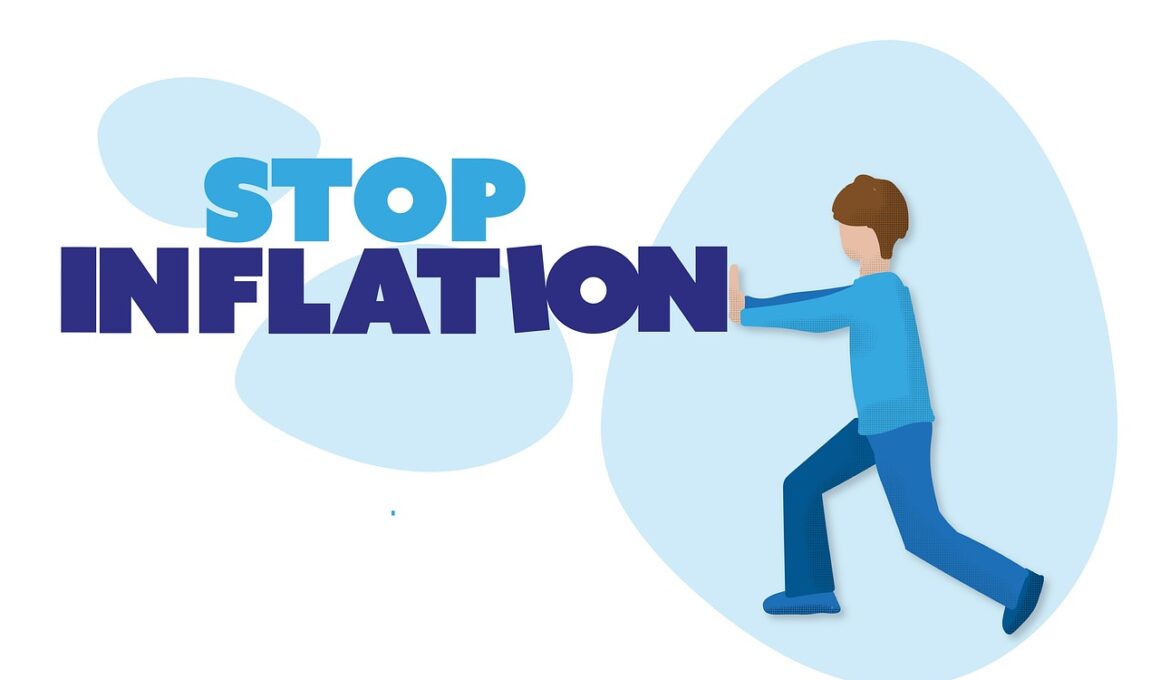How Inflation Expectations Shape Interest Rate Markets
The relationship between interest rates and inflation continues to be a crucial topic for economists and investors alike. Interest rates are primarily influenced by inflation expectations, which refer to the public’s beliefs about future financial conditions. As inflation rises, central banks typically respond by increasing interest rates to control economic overheating. This action is taken to curb consumer spending and borrowing, which can lead to higher price levels. Consequently, higher interest rates often lead to lower consumer demand and investment, slowing down economic growth. Investors closely watch indicators of inflation expectations, such as Consumer Price Index (CPI) and Producer Price Index (PPI) announcements, as these figures can directly affect market dynamics. For example, when inflation expectations rise, bond prices may fall, reflecting the anticipated increase in yields. The Federal Reserve and other central banks have tools like monetary policy adjustments, and these decisions are often dictated by inflation forecasts. Thus, understanding how inflation expectations shape interest rates provides a foundation for making informed investment decisions and preparing for future market fluctuations. Ultimately, the interplay between inflation and interest rates is a critical component of economic stability.
In recent years, the debate surrounding the efficiency of interest rates in controlling inflation has gained significant attention. Many argue that traditional monetary policy tools may not effectively address persistent inflation pressures. The expectation that higher interest rates can sufficiently curb inflation is increasingly questioned. Some economists propose that the relationship is not as straightforward as once thought. They suggest that external factors, such as supply chain disruptions and geopolitical risks, also play vital roles in shaping inflation dynamics. Moreover, the global economy is interconnected, meaning actions taken in one country might impact inflation elsewhere. For instance, if a central bank raises rates, it might inadvertently strengthen its currency, affecting exports and imports. This interplay complicates the relationship and requires a more nuanced understanding of the global economic landscape. Additionally, consumer behavior is significantly influenced by interest rate changes. Increased borrowing costs may lead consumers to reduce spending, thereby impacting overall economic growth. However, in a low-interest rate environment, individuals might find it easier to take on debt, potentially fostering spending. This complexity illustrates the importance of a comprehensive analysis when evaluating the impact of interest rates on inflation.
Market Reactions to Inflation Indicators
The reaction of financial markets to inflation data is crucial for predicting shifts in interest rates. Market participants often adjust their expectations based on the latest inflation reports. For example, a higher-than-expected CPI reading can lead to an immediate sell-off in bond markets, reflecting fears of increased interest rates. Such reactions demonstrate the sensitivity of the financial markets to inflation data and the implications for interest rates. Investors need to be aware that the current market sentiment can lead to volatility. It is essential to monitor central bank communications as well, since policymakers often provide guidance on their views regarding inflation risks. Furthermore, the relationship between inflation expectations and interest rates can also be seen in the yield curve, which reflects the interest rates offered on bonds of different maturities. A steep yield curve typically indicates that investors expect stronger economic growth, along with higher inflation, prompting future interest rate hikes. Conversely, an inverted yield curve may signal a looming recession, leading to expectations of lower inflation and interest rates. Therefore, understanding market reactions to inflation is an invaluable skill for navigating the financial landscape.
The long-term inflation expectations have a profound effect on the overall interest rate environment. When individuals foresee persistent inflation, they are more likely to demand higher nominal interest rates to compensate for the diminished purchasing power of future cash flows. This behavior typically involves adjusting savings and investment strategies. Investors often seek to protect their portfolios by favoring assets that can preserve value during inflationary periods, such as commodities or real estate. Conversely, when inflation expectations are subdued, interest rates tend to remain lower, creating a favorable environment for borrowing. Central banks often take measures to anchor inflation expectations to ensure economic stability. This includes utilizing forward guidance, which communicates their intentions regarding interest rate policies, helping to manage market expectations. Additionally, inflation-targeting frameworks can help maintain price stability and influence interest rates over the long term. Such strategies aim to reassure consumers and investors about the central bank’s commitment to controlling inflation. Overall, the interplay between inflation expectations and interest rates is critical for making sound economic decisions and planning for future financial outcomes.
The Role of Central Banks in Interest Rate Decisions
Central banks play an indispensable role in guiding interest rates influenced by inflation expectations. These institutions carefully monitor economic indicators to inform their policy decisions. For instance, when inflation exceeds targeted levels, central banks may raise interest rates to curb excessive borrowing and spending. This proactive approach helps restore price stability, ultimately affecting consumer and business confidence. Moreover, central banks often employ various monetary policy tools, such as open market operations, to influence the money supply and interest rates. By adjusting the rates at which banks lend to each other, they can indirectly affect the rates consumers and businesses pay for loans. It’s important to note that central banks also face challenges in managing inflation and interest rates in a globalized world. Factors like foreign investment, trade policies, and global economic trends can complicate domestic monetary policies. Consequently, central banks must strike a balance between controlling inflation and fostering economic growth. Understanding the central bank’s role in shaping interest rate markets is crucial for interpreting monetary signals and their broader implications for the economy.
The expectations surrounding inflation are subject to various influences, including demographic trends and global economic events. For instance, an aging population may lead to decreased demand for certain goods and services, affecting inflation dynamics. Conversely, emerging markets may experience inflation spikes as their economies grow and consumption rises. Additionally, geopolitical tensions and natural disasters can disrupt supply chains, influencing inflationary pressures around the world. Policymakers must consider these factors when making decisions on interest rates. The uncertainty surrounding inflation expectations often leads to fluctuations in financial markets, as investors react to emerging information. When anticipating rising inflation, they may prefer to invest in assets like stocks or gold, which are traditionally seen as hedges against inflation. On the other hand, infrequent reports of low inflation may encourage investment in bonds, given lower associated risks. Consequently, understanding the nuanced relationship between inflation expectations and market behavior is critical for informed investing. Staying attuned to both local and international news can help investors navigate this dynamic environment more effectively.
Conclusion: The Future of Interest Rates and Inflation
As we consider the future of interest rates and inflation, it’s essential to recognize how interconnected these factors are. Given the ongoing economic shifts, potential volatility in inflation rates is anticipated, prompting central banks to remain proactive in their responses. Moreover, as economies recover from unprecedented circumstances such as global pandemics, inflationary pressures may cause new complexities. Individuals and investors alike must stay informed about economic indicators, central bank interests, and how inflation expectations can reshape financial landscapes. Preparations should be made based on potential scenarios to maintain financial stability. Additionally, understanding consumer behavior and expenditure patterns becomes increasingly vital for anticipating how inflation may affect interest rates. This awareness will facilitate informed investment choices within the context of rising inflation expectations. Interest rates, modified by inflation expectations, will undoubtedly play a crucial role in shaping market conditions. Awareness of these dynamics can empower stakeholders to make better, informed financial decisions and contribute to a more stable economic environment.


